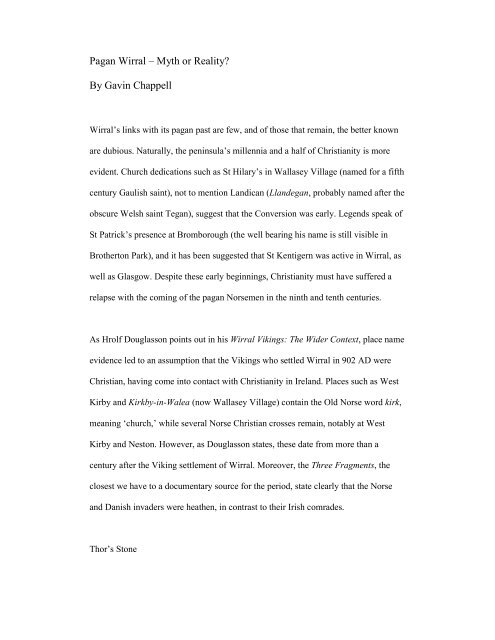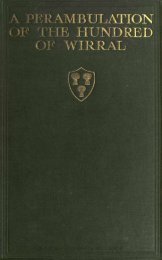Pagan Wirral – Myth or Reality? By Gavin Chappell - Old Wirral.com
Pagan Wirral – Myth or Reality? By Gavin Chappell - Old Wirral.com
Pagan Wirral – Myth or Reality? By Gavin Chappell - Old Wirral.com
Create successful ePaper yourself
Turn your PDF publications into a flip-book with our unique Google optimized e-Paper software.
<strong>Pagan</strong> <strong>Wirral</strong> <strong>–</strong> <strong>Myth</strong> <strong>or</strong> <strong>Reality</strong>?<br />
<strong>By</strong> <strong>Gavin</strong> <strong>Chappell</strong><br />
<strong>Wirral</strong>’s links with its pagan past are few, and of those that remain, the better known<br />
are dubious. Naturally, the peninsula’s millennia and a half of Christianity is m<strong>or</strong>e<br />
evident. Church dedications such as St Hilary’s in Wallasey Village (named f<strong>or</strong> a fifth<br />
century Gaulish saint), not to mention Landican (Llandegan, probably named after the<br />
obscure Welsh saint Tegan), suggest that the Conversion was early. Legends speak of<br />
St Patrick’s presence at Bromb<strong>or</strong>ough (the well bearing his name is still visible in<br />
Brotherton Park), and it has been suggested that St Kentigern was active in <strong>Wirral</strong>, as<br />
well as Glasgow. Despite these early beginnings, Christianity must have suffered a<br />
relapse with the <strong>com</strong>ing of the pagan N<strong>or</strong>semen in the ninth and tenth centuries.<br />
As Hrolf Douglasson points out in his <strong>Wirral</strong> Vikings: The Wider Context, place name<br />
evidence led to an assumption that the Vikings who settled <strong>Wirral</strong> in 902 AD were<br />
Christian, having <strong>com</strong>e into contact with Christianity in Ireland. Places such as West<br />
Kirby and Kirkby-in-Walea (now Wallasey Village) contain the <strong>Old</strong> N<strong>or</strong>se w<strong>or</strong>d kirk,<br />
meaning ‘church,’ while several N<strong>or</strong>se Christian crosses remain, notably at West<br />
Kirby and Neston. However, as Douglasson states, these date from m<strong>or</strong>e than a<br />
century after the Viking settlement of <strong>Wirral</strong>. M<strong>or</strong>eover, the Three Fragments, the<br />
closest we have to a documentary source f<strong>or</strong> the period, state clearly that the N<strong>or</strong>se<br />
and Danish invaders were heathen, in contrast to their Irish <strong>com</strong>rades.<br />
Th<strong>or</strong>’s Stone
The place popularly associated with the Vikings in <strong>Wirral</strong> is Th<strong>or</strong>’s Stone (also<br />
known as Th<strong>or</strong>’s Rock), on Thurstaston Common, a massive block of sandstone that<br />
sits in a natural amphitheatre, surrounded by wood and heathland. Acc<strong>or</strong>ding to local<br />
legend, this ‘gigantic rock altar’ is the site of Viking religious rites in honour of the<br />
thunder god Th<strong>or</strong> <strong>–</strong> the red rock is stained with the blood of victims! <strong>–</strong> <strong>or</strong> else was<br />
raised by the Vikings to <strong>com</strong>mem<strong>or</strong>ate the Battle of Brunanburh in 937 (supposedly<br />
fought at Bromb<strong>or</strong>ough), <strong>or</strong> in a tradition rec<strong>or</strong>ded by Profess<strong>or</strong> Steve Harding in<br />
Ingimund’s Saga, it is the location of Th<strong>or</strong>’s Hammer, the weapon the N<strong>or</strong>se god uses<br />
to defend the w<strong>or</strong>ld from the frost giants. But is there truth in any of these st<strong>or</strong>ies?<br />
No, would appear to be the sh<strong>or</strong>t answer. Writing in Notes & Queries in November<br />
1877, local w<strong>or</strong>thy Sir James Picton brought to the attention of the general populace<br />
the ‘Great Stone of Th<strong>or</strong>’ a ‘very interesting relic of Saxon <strong>or</strong> Danish heathendom.’<br />
Stating that there was no local legend about it, and that local hist<strong>or</strong>ians did not<br />
mention it, he linked the rock with the township in which it was located, suggesting<br />
that it was ‘Th<strong>or</strong>’s Stone,’ and that the name Thurstaston came from Th<strong>or</strong>s-stane-tun,<br />
<strong>or</strong> the town of Th<strong>or</strong>’s Stone. His real agenda was to stop the encroachment of<br />
developers in the area, and the article is directly responsible f<strong>or</strong> Thurstaston Common<br />
be<strong>com</strong>ing a public park rather than a Vict<strong>or</strong>ian housing development.<br />
Regardless of this, the st<strong>or</strong>y grew and grew. The associations between Th<strong>or</strong>’s Stone<br />
and pre-Christian religion were such that in the late nineteen eighties, members of an<br />
<strong>or</strong>ganisation called the Hearth of the Sons of Odin provoked a min<strong>or</strong> fur<strong>or</strong>e when they<br />
‘reclaimed’ the rock f<strong>or</strong> the w<strong>or</strong>ship of Th<strong>or</strong> and other N<strong>or</strong>se gods. Spoilsp<strong>or</strong>t<br />
academics maintain that the association is bogus: ‘Thurstaston’ actually derives from
‘Th<strong>or</strong>steins tun,’ <strong>or</strong> the farm of Th<strong>or</strong>stein (a popular name in the Viking Age). So the<br />
myth has been debunked. Th<strong>or</strong>’s Stone, despite its symbolic status relating to <strong>Wirral</strong>’s<br />
Viking heritage, had no pagan connections pri<strong>or</strong> to 1989. Various the<strong>or</strong>ies have been<br />
advanced to explain the existence of the rock outcrop, including the possibility that it<br />
was part of a quarry, perhaps the site of a crane f<strong>or</strong> loading stone into carts. However,<br />
no rec<strong>or</strong>ds exist of such a quarry and it is w<strong>or</strong>th pointing out that, although Th<strong>or</strong>stein<br />
was indeed a N<strong>or</strong>se personal name, it means ‘Th<strong>or</strong> stone.’<br />
The Journal of the British Archaeological Association, Vol. XLIV, printed in 1888,<br />
included an article describing a trip made by its members to <strong>Wirral</strong>, during which they<br />
visited ‘the Th<strong>or</strong> Stone’ where Picton himself regaled them with its supposed hist<strong>or</strong>y.<br />
Again, he maintained that no legend was associated with the area (clearly unaware<br />
that he had invented one) but he was c<strong>or</strong>rected by the Reverend A. E. P. Gray, Rect<strong>or</strong><br />
of Wallasey, who said that<br />
…the people round about the country gave the name of “Fair Maidens' Hall”<br />
to the place where the Stone stood, and … the children were in the habit of<br />
<strong>com</strong>ing once a year to dance round the Stone….<br />
Obscure folkl<strong>or</strong>ic rites such as these are often held to represent traditions dating back<br />
to pagan antiquity. Perhaps no one pri<strong>or</strong> to Picton had linked the rock with the mighty<br />
Thunderer of N<strong>or</strong>se religion, but this picturesque area was the centre of earlier<br />
traditions. Certainly this f<strong>or</strong>gotten folk custom is m<strong>or</strong>e authentic than the<br />
reconstructed rites of the Sons of Odin, <strong>or</strong> the Mayday M<strong>or</strong>ris dancing encouraged by<br />
Profess<strong>or</strong> Harding.
<strong>Pagan</strong> Survivals<br />
But do genuine pagan survivals exist in <strong>Wirral</strong>? Further place name evidence reveals<br />
the existence of pre-Christian burial practices. The Arno in Oxton is not named after<br />
the famous Italian river, but rather represents a w<strong>or</strong>n-down f<strong>or</strong>m of the <strong>Old</strong> N<strong>or</strong>se<br />
Arnis-haugr, the ‘burial mound of Arni’, an otherwise unsung Viking. In Meols,<br />
meanwhile, we find F<strong>or</strong>nall Green, derived from F<strong>or</strong>n-haugr, the ‘ancient burial<br />
mound.’ In Birkenhead Park there were two burial mounds known locally as ‘the<br />
Bonks,’ which acc<strong>or</strong>ding to Caton’s Romance of <strong>Wirral</strong> were the scene of Easter<br />
celebrations by local children, which included rolling eggs up the mounds. Despite (<strong>or</strong><br />
perhaps due to) their popularity with children, these prehist<strong>or</strong>ic monuments became<br />
an eyes<strong>or</strong>e in the local council’s opinion, and were demolished.<br />
Up on Bidston Hill, near the Observat<strong>or</strong>y, are several rock carvings, including one of<br />
a h<strong>or</strong>se, reputedly facing towards the midsummer sunrise; one of a sun goddess; and<br />
another (very w<strong>or</strong>n) of a moon god. These are usually said to be the w<strong>or</strong>k of the<br />
Vikings, around 1000 AD. There is no real evidence f<strong>or</strong> this, although N<strong>or</strong>se<br />
mythology certainly includes a sun goddess, Sol, a moon god, Mani, and Arvakr, a<br />
h<strong>or</strong>se with solar connections. However, the date of 1000 AD seems too late f<strong>or</strong><br />
heathen N<strong>or</strong>semen in <strong>Wirral</strong>, being only a few decades pri<strong>or</strong> to the carving of the<br />
N<strong>or</strong>se crosses at West Kirby and elsewhere. The sparse evidence suggests that<br />
heathenism flourished in the tenth century, bef<strong>or</strong>e dying out in the eleventh <strong>–</strong> by the<br />
end of which century N<strong>or</strong>way and Denmark were both staunchly Christian.
Harrow Fields<br />
Another source of evidence f<strong>or</strong> paganism in <strong>Wirral</strong> is to be found in place names and<br />
field names containing the element ‘harrow.’ This derives from the <strong>Old</strong> English<br />
hearg, meaning a pagan shrine, related to the <strong>Old</strong> N<strong>or</strong>se hörg. A harrowe hay is<br />
rec<strong>or</strong>ded in Heswall in 1293, while a whole crop of ‘harrow’ field names is to be<br />
found not far from the apocryphal Th<strong>or</strong>’s Stone.<br />
First mentioned in two academic articles published in 1993, Harrow Fields lie<br />
between <strong>Old</strong>field and Thurstaston, on either side of Telegraph Road. A field-walking<br />
expedition carried out a year earlier by Rob Philpott of Liverpool University yielded<br />
many archaeological relics suggesting occupation of the area from prehist<strong>or</strong>y until the<br />
Viking Age. Linking the field names with the long period during which the site was<br />
occupied, Sarah Semple of Durham University concluded that this area was the scene<br />
of pre-Christian religious ritual in the Viking Age, the Saxon period, during the<br />
Roman occupation, and throughout the Iron and Bronze Ages, the New Stone Age<br />
and all the way back to the Middle Stone Age, between 9000 and 7000 years ago. Dr<br />
Semple maintains that this the<strong>or</strong>y is reinf<strong>or</strong>ced by the continuity of religious and ritual<br />
connections with the area: not only the close proximity of Thurstaston Rect<strong>or</strong>y, but<br />
also the fact that to the present day, Thurstaston Common continues to be the focus<br />
f<strong>or</strong> ‘low-level ritual activity.’<br />
Perhaps Sir James Picton wasn’t so wrong after all.<br />
First published in the Heswall Magazine




